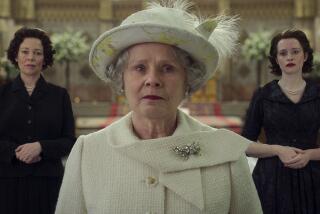‘Six Wives’ would put Henry to sleep
- Share via
It wasn’t easy being queen to Henry VIII. “Divorced, beheaded, died/divorced, beheaded, survived” is how a British rhyme neatly summarizes what happened to the 16th century ruler’s wives.
It’s a bit more complicated than that, actually, which explains why the new PBS documentary “The Six Wives of Henry VIII” is four hours long. And why historian David Starkey can maintain his enthusiastic narration for the duration. Too bad the program doesn’t match his energy.
It begins with two hours tonight at 9 on KCET-TV and will conclude next Wednesday, looking to put a fresh spin on history by examining the lives of Henry’s queens from their perspective. Starkey quotes the women’s writings and other material to tell their stories of strength and weakness, of being players and being played in the royal court.
The first hour focuses on Catherine of Aragon, daughter of King Ferdinand and Queen Isabella of Spain. She initially married Henry’s older brother Arthur, but after he died, Henry took her as his own wife. They proved to be a formidable couple -- in marriage and in divorce proceedings. Thanks in large part to her fierce resistance and ties to Catholicism, Henry founded England’s own church so he could get an annulment.
Naturally, Henry already had another wife lined up -- Anne Boleyn, to whom “Six Wives” devotes the second hour. Her equally willful nature contributed to her demise at the hands of the executioner.
Next week’s installment profiles Jane Seymour, who died from complications of childbirth after doing what Catherine and Anne couldn’t: provide a male heir; Anne of Cleves, who proved so unattractive to Henry that she was essentially bribed to leave the palace; teenage Catherine Howard, who was beheaded on charges of promiscuity; and Catherine Parr, who was in love with another man but wed the king because she said God had told her to.
“Six Wives” presents a lot of interesting history, but visually speaking, it’s a bore. Though viewers can see several castles and a handsome cast in period costumes, the four hours contain almost no speaking roles or action.
Indeed, the camera moves about more than the actors do, giving the effect of watching an oil painting being filmed. And when the scene switches to a nondescript shot of a stone floor, a window, water or the sky, as it repeatedly does, it’s like watching the paint dry.
More to Read
The complete guide to home viewing
Get Screen Gab for everything about the TV shows and streaming movies everyone’s talking about.
You may occasionally receive promotional content from the Los Angeles Times.






